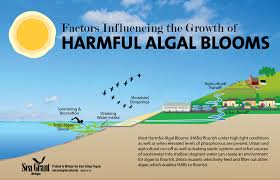 You may have heard about the risk of blue-green algae in water sources, in the new recently. It is important to know that ingestion of these algae and the chemicals they contain is a heath hazard to dogs as well. The danger of them swimming in lakes that are covered in algae are real. Without making you paranoid, it is good to be able to know which lakes to avoid, and the ones that look like the picture here, with a blue or green iridescent paint color on the surface should be avoided.
You may have heard about the risk of blue-green algae in water sources, in the new recently. It is important to know that ingestion of these algae and the chemicals they contain is a heath hazard to dogs as well. The danger of them swimming in lakes that are covered in algae are real. Without making you paranoid, it is good to be able to know which lakes to avoid, and the ones that look like the picture here, with a blue or green iridescent paint color on the surface should be avoided.
Cyanobacteria (also known as blue-green algae) are microscopic bacteria found in freshwater lakes, streams, ponds and brackish water ecosystems. They colonize into “blooms”, and can give the water a “pea-soup” appearance. They also can produce mycrocystins and anatoxins, that affect people, livestock and pets that swim and drink from the water. Because the algae float, they may be blown by the wind into thick, concentrated mats near the shore, thus making them easily accessible to animals. Algal concentrations vary throughout the year, but are most abundant during periods of hot weather in mid-to late-summer months, and are most likely to be found in nutrient-rich water. While most blue-green algae blooms do not produce toxins, it is not possible to determine the presence of toxins without testing. Thus, best to err on the side of caution and avoid these areas. Very small exposures, such as a few mouthfuls of algae-contaminated water, may result in fatal poisoning.
The “cyano” in cyanobacteria comes not from the fact that they produce cyanide (they do not), but from the blue (‘cyan’) green coloration. The toxic principles in cyanotoxins vary, mainly neurotoxins and hepatotoxins (liver toxins). The most common, microcystin, produces liver injury similar to that seen with hepatotoxic mushrooms, but with a more rapid onset of signs. Bloodwork changes include elevated liver enzymes, low blood sugar, low protein, and sometimes abnormal clotting ability. In severe cases, acute shock and death may occur within a few hours. Treatment is aimed at addressing the liver damage, and give supportive care, hopefully asap.
Anatoxins result in neurotoxity, which might cause an animal to have excessive secretions, such as salivation and tearing, or neurologic signs, including muscle tremors, muscle rigidity, or paralysis. The skin may appear blue, and the animal may have difficulty breathing. Treatment included anti-seizure medication, oxygen,and other aggressive treatment by a veterinarian. There is no antidote for either of these toxins.
A more detailed list of common signs to look for:
vomiting
diarrhea
blood in stool or black, tarry stool
pale mucous membranes,
jaundice
seizures
disorientation
coma
shock
excessive salivation or tearing
muscle tremors, muscle rigidity, paralysis
blue discoloration of the skin and mucous membranes
difficulty breathing
death
If you suspect your dog was exposed to blue-green algae, contact your veterinarian asap. You can also contact Pet Poison Helpline for guidance, 1-800-213-6680.
Dr. Dawn
Please share and subscribe here




